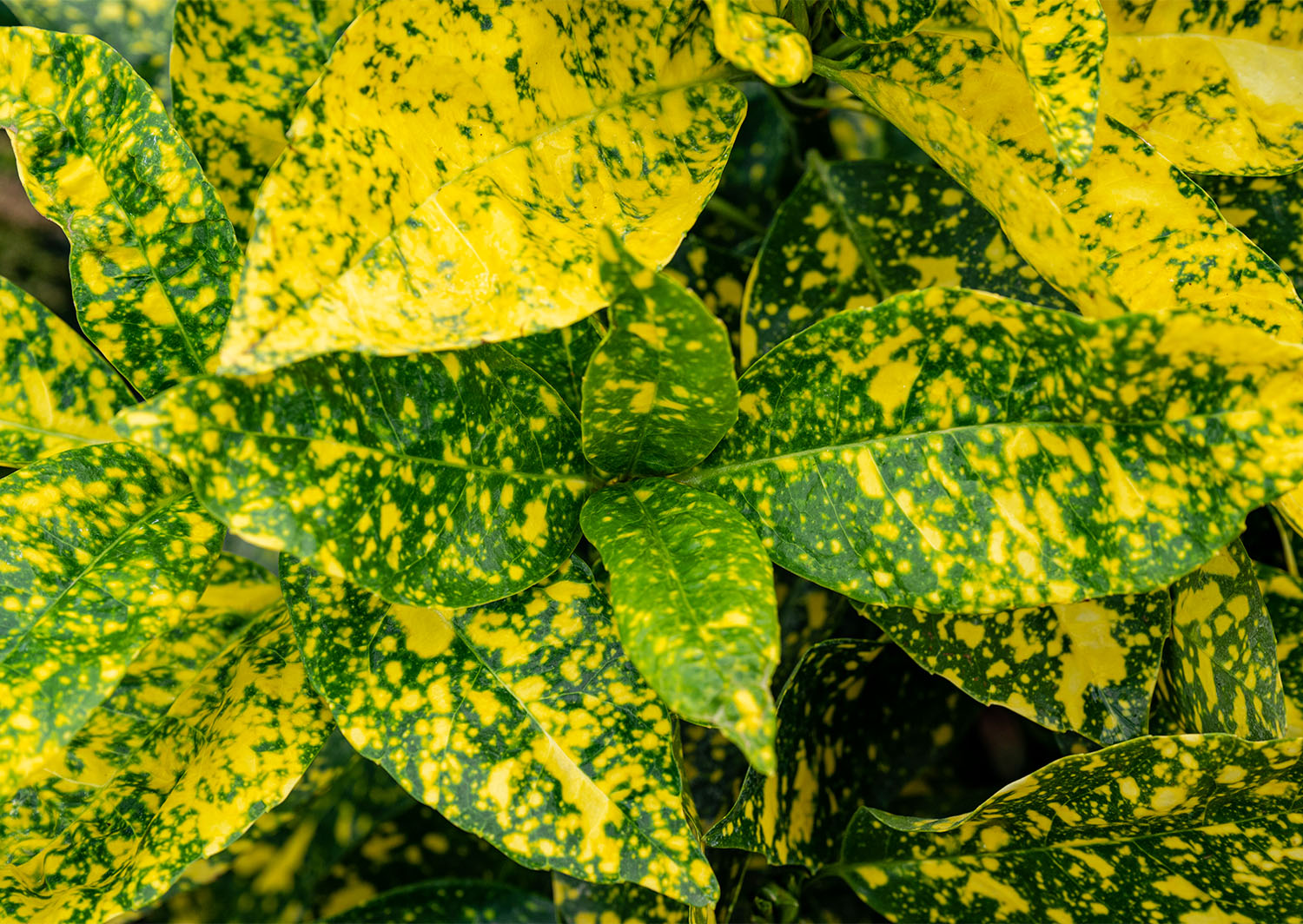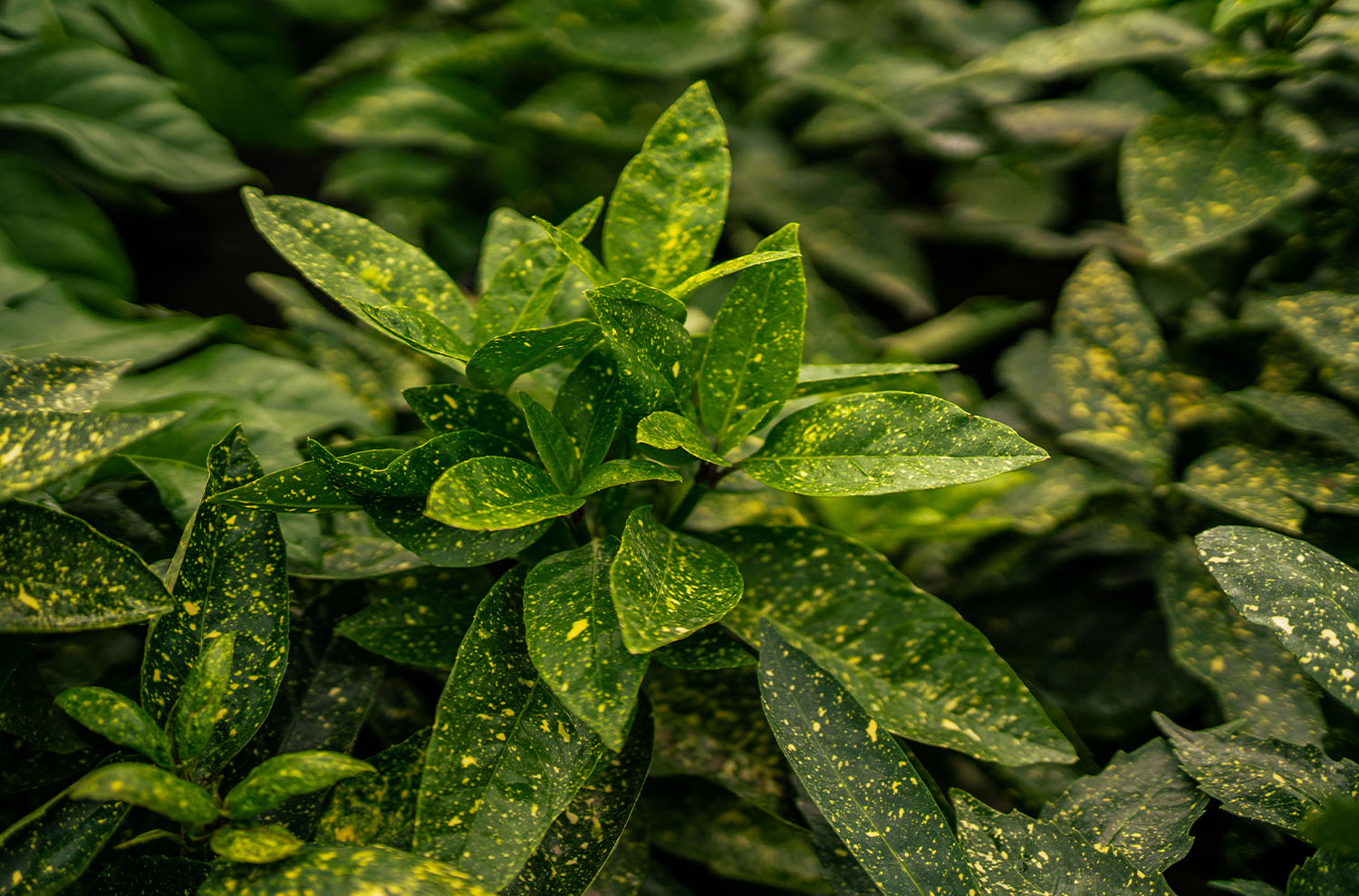Plant Focus: Aucuba japonica
Vibrant evergreen, the perfect choice for urban enviroments.
Aucuba japonica, commonly known as Japanese Laurel, is a small evergreen shrub that can reach up to two meters in height when fully developed. Native to China, Japan and the Himalayan region, this plant grows naturally in the undergrowth of mountain and hilly forests. Aucuba are dioecious, meaning that they have male and female reproductive structures in separate plants. They were introduced to Europe in 1783 by the German botanist John Graeffer, however, all of the initial plants imported were female, and consequently lacked their characteristic red fruits. Only thanks to one of Fortune’s travels in the 19th century did male specimens arrive in the West, allowing pollination and the appearance of the berries.
Initially grown as heated greenhouse plant, Aucuba japonica soon became popular among 19th-century gardeners for its resistance to the pollution and low light of industrialised cities. Today it is common in gardens, appreciated for its red fruits, which are gathered in branched clusters.
Key Characteristics:
✓ Evergreen shrub
✓ Height up to 3m
✓ Variegated varieties
✓ Prefers shade or partial shade
✓ Low maintenance
✓ Tolerates low temperatures
✓ Pollution resistant
✓ Attracts birds thanks to its berries
✓ Dioecious plant

Aucuba japonica has dense, rounded foliage, with large, bright green leaves, which can be variegated white or yellow depending on the species. During early spring, it produces small purple-brown flowers. When pollinated, these flowers produce bright red berries in female plants, which mature in autumn and remain on the plant throughout the winter, adding an interesting pop of colour to the garden during the darker months. Fruits are only produced by female specimens and only if there are male plants nearby to pollinate. Berries, in addition to their decorative value, are important for wildlife. Despite being toxic to humans and pets, they provide much needed nutrition for birds during winter.
Aucuba japonica thrives in semi-shaded positions and tolerates low temperatures, making it ideal for urban environments. In China, pounded leaves were used in folk medicine to treat burns, swelling and chilblains, and scientific studies have demonstrated their potential as a protective factor against damage caused by UVB rays.
Aucuba japonica requires moist but well-drained soil and can be watered moderately. Once established, it is drought tolerant and requires only occasional pruning to maintain shape. With remarkable cold tolerance, it can survive temperatures as low as -15°C, making it suitable for outdoor cultivation, even during the harshest winters.
Did you know?
Aucuba japonica owes its name to the intense green of its leaves. In Japanese, the name アオキ (Aoki) has a double meaning: evergreen shrub but also blue tree. In ancient Japanese there were only four words for colours: red, blue, black and white. For this reason greens were also identified with the word blue 青 (ao, blue). Today Japanese has many words for colours, but 青 (ao, blue) is still used for bright greens, especially when referring to lush vegetation.
Our favourite varieties of Aucuba japonica
Aucuba japonica
A rounded shrub with leathery, oval-shaped leaves. The leaves are can vary slightly in size, with some varieties having slightly wavy or serrated margins. Aucuba japonica flowers sporadically in spring, producing small reddish-purple inflorescences that add a pop of colour to the green foliage. Blooms small, purple flowers in spring, followed by clusters of egg-shaped, red berries in autumn, if pollinated.
Aucuba japonica ‘Crotonifolia’
The ‘Crotonifolia’ variety is particularly popular for its distinctive and decorative leaves. This variety features large, glossy, dark green leaves that are accented by bright yellow or cream spots randomly arranged along the edges. In spring, small reddish-purple blooms may appear, followed by small red or purple berries that persist into autumn, adding further decorative elements to the plant.

Aucuba japonica ‘Crotonifolia’
Aucuba japonica ‘Picturata’
Aucuba japonica ‘Picturata’ is a vigorous, evergreen shrub with variegated, glossy, green foliage that has yellow speckled margins and a dramatic, central splash of yellow. As per all the Aucuba varieties it blooms small, purple flowers in spring which give rise to red berries. With a rather collected habit, it reaches approximately 150 cm in height.
Aucuba japonica ‘Rozannie’
The ‘Rozannie’ variety is a drought tolerant, evergreen shrub with lance-shaped, glossy green foliage and small purple-red, spring flowers. Aucuba japonica ‘Rozannie’ has a compact and dense growth habit, making it ideal for use as a border plant or as a filler in the narrowest spaces of the garden. ‘Rozannie’ is a self-pollinating variety, meaning it is capable of producing bright red berries without the need for another plant for cross-pollination.

Aucuba japonica ‘Picturata’ – Photo by © Leonora (Ellie) Enking

Aucuba japonica ‘Rozannie’
Aucuba japonica ‘Variegata’
An evergreen, drought-tolerant laurel, which is prized for its large, glossy, yellow-spotted foliage. The leaves of this variety are ovate in shape and have a combination of colours ranging from dark green to light green, enriched by yellow or white variegations that extend along the edges of the leaves or appear in spotted shapes across the entire leaf blade. This variegated pattern gives the plant a vibrant, eye-catching appearance, making it ideal for use as a focal point or contrasting element in gardens and landscapes. A great species for hedging in urban locations, due to its dense growth habit, and it thrives in shaded positions. Aucuba japonica ‘Variegata’ blooms small, purple flowers in spring, with occasional red berries if pollinated by a nearby male plant.

Aucuba japonica ‘Variegata’© Leonora (Ellie) Enking

Aucuba japonica ‘Variegata’
How to grow and care for Aucuba japonica:
Aucuba japonica varieties are low-maintenance plants perfect for shaded areas of the garden, but they still require some precaution to ensure their correct development and maintenance.
Aucuba japonica does not tolerate direct sunlight, for this reason it must be placed in shaded or semi-shaded areas, which makes it a perfect choice for dark corners of gardens or under the shade of trees. It pairs well with other shade-loving plants such as Rhododendron and Hydrangea. Aucuba japonica suffers from water stagnation, so you must ensure that it is always in moist but well-drained soil to avoid root rot.
Aucuba japonica does not require pruning except to remove damaged branches or contain its shape. The same goes for fertilisation, which is not necessary, but if done during the growing season, can improve growth and health.
Aucuba has excellent resistance to the cold, but it is recommended to protect in case of extreme cold or if the plant is still young.
Pests and diseases:
Although this plant is generally robust and resilient, it can be susceptible to various issues, especially when growing conditions are less than ideal. One of the most common diseases affecting Aucuba japonica is leaf spot, caused by fungi such as Cercospora aucubae. This disease manifests as dark or brown spots on the leaves, compromising the plant’s visual appeal. Another threat to Aucuba japonica is powdery mildew, caused by the fungus Oidium. This disease presents as a powdery white coating on the leaves, reducing the plant’s ability to photosynthesise and compromising its overall health. Good drainage and the use of fungicides can help manage these issues. Additionally, attacks by pests such as mites and aphids can weaken the plant, causing leaf discoloration or deformation. The use of insecticides or biological controls can be effective in these cases. Lastly, root rot is often the result of excessive moisture in the soil. Ensuring the plant is in well-drained soil can help prevent it. Fortunately, there are biological control methods that can help manage these diseases sustainably, reducing reliance on chemical pesticides and protecting the environment.
For more information about Greenwood’s Aucuba japonica varieties, speak to the G Team today.

